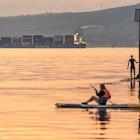
Jul 11, 2022 • 8 min read

You may have to wrap up warm in the off-season but the lack of crowds and lower prices make Ireland the place to be © David Levingstone / Getty Images
Ireland's famously lush green landscape may be partly due to its unpredictable weather but don't let a chance of rain spoil your trip to this wonderful island nation.
No matter when you choose to visit, there'll be no shortage of fun things to do – hiking through stunning scenery, catching up with locals in a cozy pub, enjoying incredible food and joining in the celebrations at one of the many festivals that pack the Irish calendar.
Though the summer months enjoy the highest temperatures, Ireland's year-round temperate climate rarely freezes in winter or blisters in summer making it possible to enjoy outdoor activities at any time.
The end of October marks the year’s passage from long days into darker evenings and keeping in tune with the passing of this season is deeply rooted in the Irish DNA. This is the time of year when things slow down as ferries to the islands scale back their service and smaller restaurants and hotels close for the season. Off-season isn’t the worst time to visit Ireland, though, as there are still plenty of things to see and do during wintertime.
The best time to visit Ireland depends on the type of trip you want to have – here's everything you need to know to help make that decision.

Along with springtime, the months of September and October can be the best time to visit Ireland to avoid crowds and save money as prices come down from their summer peak. Expect long days with mild temperatures and plenty of dry spells to explore the explosion of color throughout the island's national parks and forests. Even the famous Ring of Kerry, with its dramatic mountainous setting against a vivid ocean backdrop, can be navigated without a convoy of tour buses blocking the views.
Many of Ireland’s best festivals shift into gear at this time. Expect some tasty offerings at the Armagh Food and Cider Weekend or Galway’s International Oyster and Seafood Festival in September. County Cork goes big in October with the Kinsale Gourmet Festival and Guinness Jazz Festival and a spooky twist brings the month to a close with a spectacular parade at the Galway Aboo Halloween Festival. If you're in Dublin, the hometown of Dracula’s creator, catch the Bram Stoker Festival.
For some, an evening in a cozy pub before turning in for the night in a thatched cottage as an Atlantic gale bellows outside is the ultimate romantic getaway. For others, it’s the lantern-lit, cobbled lanes of Kilkenny, Limerick or Galway that offer the perfect winter break – all the benefits of good transport links to scenic locations and a wide selection of restaurants and hotels offering off-peak rates to while away the long evenings.
However, with shorter days, the occasional storm and icy road conditions, any independent road trips should stick to main roads and motorways. Apart from the heavy-hitting tourist attractions like the Cliffs of Moher, The Rock of Cashel, Bunratty Castle or urban museums, many of the interpretive centers close for the season, while transport services scale back and remote hospitality goes into winter hibernation.
The holiday season is celebrated throughout December in Ireland, so expect plenty of Christmas markets in places like Eyre Square in Galway or The Milk Market in Limerick. Things are a little quieter in January as the whole country recovers from the endless festive activities but Tradfest gets everyone back in the party spirit towards the end of the month. A little bit of Hollywood magic descends on the capital to celebrate the Dublin Internation Film Festival at the end of February and the national rugby team roars into action with the (literal) kick-off of the Six Nations Tournament.

Let’s face it – St Patrick dominates the entire month of March in Ireland. It’s also when the tourism and transport industries come to life after their winter respite. While weather conditions are still unsettled, the thermometer edges up to 10°C (50°F) and days are much lighter.
The St Patrick’s Day Parade takes center stage in towns and cities across the country with floats, jigs, reels and pints of creamy Guiness as everyone celebrates sentimental shenanigans and silliness. And yes, expect price hikes in hotels for that week. Unsurprisingly, Dublin has the biggest parade that dominates the streets of the capital. However, country parades like the County Clare procession in Doolin offer a satirical take on the larger events and can be equally rewarding.
The global phenomenon of lighting sites up in green is predictably rampant in Ireland and can create an atmospheric glow against the limestone render of medieval buildings. Top tip for visitors: it's Paddy's Day, not Patty's Day. The only patty is the one in your burger.
With temperatures an average high of 18°C (64°F) and prices that haven’t maxed out yet, this is the best time to take a road trip along Ireland’s magnificent Wild Atlantic Way. It’s a 2600-km (1600 miles), signposted west coast route that connects west Cork in the south to Donegal in the north. It’s also the best time to visit Ireland for a round of ten of golf; play on links near charming villages, white sandy beaches, coves, castles teetering on cliff tops and vibrant towns like Westport or Sligo.
Blossoms burst into life throughout the country from April, so visit the garden county, Wicklow, to catch bluebell season at Powerscourt or Glendalough. County Clare’s Burren in Bloom festival in May is a great way to see rare species in a spectacular moonscape setting.
It can also be the best time to visit Dublin as June kicks off with the Flowers, Food and Family Festival shortly before the city hosts Bloomsday on June 16, a celebration of writer James Joyce’s blossoming of a different nature. The festivities are followed a couple of weeks later with a sea of rainbow flags with the country’s biggest LGBTIQ+ Pride Festival.

First the bad news: all Irish schools and colleges are now closed for the summer, so you’re competing with the home market when it comes to accommodations, food, car hire and visitor attractions. That means higher prices and busy beaches (when the sun is out). Leaving bookings to the last minute at hotels and restaurants in popular locales is risky and not recommended. Galway is booked and busy in July when the Galway International Arts Festival brings visitors from far and wide, while the streets of Miltown Malbay are filled with music and dance during the Willie Clancy Summer School.
However, it's an excellent time to stay on an island like the Arans or Inishbofin, where bikes are the best form of transport. Alternatively, Ireland’s lesser-visited Midlands are filled with medieval fortresses, blue river trails and quaint villages – and they’re crowd-free. There’s no better way to explore the area than hiring a boat for a cruise along the Shannon, the longest river in Ireland, to visit off-radar places like the pretty town of Killaloe, the high crosses at Clonmacnoise or Sean’s Bar, the oldest pub in Ireland. Boat hire means setting your own independent itinerary and it offers excellent value for money given you sleep on board.
Galway barely has time to recover from its Arts Festival before Race Week hits the town in late July, stretching into early August – expect glamorous outfits and high spirits. Down south, the town of Tralee warmly welcomes visitors from around the globe for the annual Rose of Tralee Festival. The words "beauty pageant" just don't do it justice and the atmosphere is incredible throughout the area.

Festivals & Events
Why you should skip St Patrick’s Day and party at Dublin Pride insteadFeb 10, 2023 • 6 min read

Jul 11, 2022 • 8 min read

Nov 21, 2024 • 9 min read

Oct 15, 2024 • 9 min read





